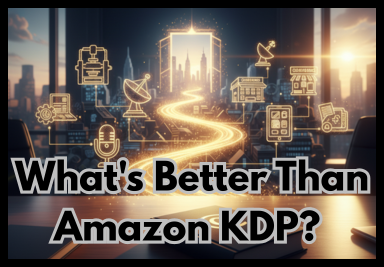Table of Contents
The self-publishing ecosystem of KDP is often framed by Amazon’s gravitational pull, with Kindle Direct Publishing (KDP) serving as the default entry point. While KDP’s giant market share and algorithmic dominance are undeniable, it grants quick reach to a massive consumer base. A critical assessment reveals its inherent structural limitations for the wise author. The better path is not a single platform but a diversified, “going wide” strategy that intentionally circumvents KDP’s exclusivity requirements and limited print-on-demand specifications.
The actual superiority lies in the technical and commercial freedom offered by platforms like IngramSpark, which provides unparalleled global print distribution (including bookstores and libraries), and key aggregators such as Draft2Digital, which facilitates simplified distribution to all major e-book retailers (Apple Books, Kobo, Barnes & Noble Press, etc.).
This intentional decentralization is the optimal approach to self-publishing, mitigating the financial and creative risks associated with monolithic dependency and ensuring greater long-term resilience and control over your intellectual property and profit margins.
What’s The Equilibrium of KDP Vs Other Platforms
The self-publishing landscape is not a proportional market but a solar system circling Amazon’s (KDP), the prevailing gravitational constant that sets the industry’s functional equilibrium. KDP, representing the most potent iteration of direct-to-consumer technology, innovatively democratized authorship, offering unmatched access to a massive, captive readership and pioneering digital royalty rates up to 70%.
This platform is an engineering marvel of retail scale, establishing the technical benchmark for ease of use and rapid time-to-market. Yet, this supremacy introduces a critical paradox for the independent creator. The magnetic pull of maximum visibility and the promotional power of KDP Select demands a strategic trade-off: platform exclusivity. This decision inevitably sparks the ongoing debate of KDP vs other platforms.
As it directly limits penetration across critical primary channels, such as Apple Books, Kobo, and, especially, Ingram Spark, which remains the necessary line for wide-reaching bookstore and library distribution.
This dynamic, a self-imposed walled garden, is compounded by internal challenges, namely chronic algorithmic volatility and the intense market saturation KDP’s own success has spurred. Ultimately, KDP defines the publishing frontier, but its vastness means that professional success hinges not just on leveraging the system, but also on critically strategizing against its monopolistic side effects.
Are There Any Websites Similar to Amazon?
Amazon is not merely an e-commerce giant, it exists as a vertically integrated logistical and data-mining platform, setting a monopolistic floor beneath the entire retail industry. Therefore, websites similar to Amazon must either mimic its operational excellence or, far more critically, carve out a technical arbitrage by exploiting the weaknesses its very scale creates.
The challenge lies in Amazon being the best version of the 21st-century fulfillment machine, offering unmatched convenience, but at the cost of seller agency and market diversity. Genuine challengers, like Alibaba, ignore the North American distribution script, instead leveraging a B2B and C2C network that dominates the Asian supply chain and consumer base, a fundamentally different, equally complex technical architecture.
Other strong competitors, such as Walmart, leverage their huge physical presence to master the omnichannel experience, incorporating local returns and in-store pickup—a logistical challenge that Amazon still finds difficult to resolve with only digital skill. Platforms like Shopify, on the other hand, deliver an important technical contrast for independent sellers:
Total brand control, direct ownership of customer data, and freedom from Amazon’s algorithmic volatility and aggressive private labeling. Any Amazon replacement must offer a basic philosophical and technical shift rather than merely a scaled-down, less efficient replica of the company’s expansive, profit-driven infrastructure in order to be viable.
Business Model of Companies Like Amazon

- The Flywheel Ecosystem: At its core, the model is not just retail but a self-reinforcing flywheel. Each business unit—e-commerce, AWS, advertising, and logistics—drives growth for the companies like Amazon. This creates immense economies of scale and an almost insurmountable competitive moat, attracting more customers and sellers in a perpetual cycle.
- Weaponized Data and Dual-Role Conflict: The platform operates in a controversial dual role as both the marketplace operator and a direct competitor to the sellers it hosts. It leverages proprietary data from third-party sellers to inform its own product development and pricing strategies, creating a significant conflict of interest and stifling competition.
- Customer Obsession as a Lock-in Mechanism: The celebrated mantra of “customer obsession” functions as a highly effective strategy for consumer data acquisition and lock-in. By offering unparalleled convenience and services like Prime, the model captures vast amounts of behavioral data, which it uses to deepen dependency and cross-sell its expanding portfolio of products and services.
- Platform Envelopment for Market Domination: The company aggressively practices platform envelopment, using the gravitational pull of its core platform to invade and disrupt adjacent markets. Ventures into groceries (Whole Foods), entertainment (Prime Video), and healthcare are not just new revenue streams but strategic moves to entangle consumers further into its ecosystem.
- Ruthless Logistical and Labor Efficiency: Underpinning the entire structure is a logistics and labor system engineered for maximum efficiency and cost reduction. This model often treats human labor as an optimizable variable within its algorithmic management systems, a practice that enables its low-cost, high-speed service but raises profound ethical questions about labor practices and the future of work.
Which Are Best Platforms for Self-Publishing Books?
- Amazon KDP (The Walled Garden): This path offers unparalleled access to the largest single market of readers and a highly streamlined user experience. The critical trade-off, however, is committing to an enclosed ecosystem, especially if you enroll in KDP Select, which demands exclusivity and limits your ability to build a presence on other platforms.
- IngramSpark & Aggregators (The Wide Distribution Path): Opting for a platform like IngramSpark provides broader distribution channels, reaching independent bookstores, online retailers beyond Amazon, and libraries. This route grants you greater control but typically involves a more complex setup process, potential upfront costs, and a steeper learning curve.
- The Fundamental Choice: The decision is not merely technical but strategic. You must weigh the immediate, concentrated reach within Amazon’s dominant marketplace against the long-term benefits of diversified distribution, higher potential royalties from other vendors, and complete autonomy over your publishing future.
Here are some more of the best platforms for self publishing books:
- Smashwords
- IngramSpark
- Draft2Digital
- Lulu
- Blurb
- BookBaby
- Kobo Writing Life
- Reedsy
- Wattpad
Netizen’s Opinion On “Is Amazon Better Than eBay”
Convenience vs. control remains the defining factor separating these two e-commerce giants, sparking frequent and often heated debate over the question: Is Amazon better than eBay? A clear technical leaning is noticeable, yet personal preferences continue to shape the discourse. Amazon is the industry leader in mass-market retail thanks to its advanced Fulfillment by Amazon (FBA) logistics network, which ensures speed and consistency of service.
Customers prioritize the “Buy Box” dependability and have an innate faith in this standardized, algorithmically-driven platform for new, commoditized goods. On the other hand, eBay fosters its reputation as a vibrant, user-focused marketplace. Commentators praise eBay’s adaptability, saying it gives sellers more control over their brands, allows them to customize their listings (including the ability to hold an auction), and has reduced fees for unusual or expensive merchandise.
The best platform for used items and collectibles, according to technical discussions, is eBay, where comprehensive listings and direct buyer-seller connection perform better than rapid, automated delivery. In the end, a critical mass of users establishes platform superiority by coordinating the platform’s fundamental operating paradigm with particular transactional goals rather than by mere volume.
Comparison Of Amazon KDP Vs Ingram Spark
You’re navigating a crucial strategic decision in your publishing career, choosing the optimal Print-on-Demand (POD) solution to maximize book visibility and profit margins. Amazon KDP offers unparalleled access to the world’s largest retail ecosystem. Its platform simplifies the author journey with zero setup fees and a user-friendly dashboard, ensuring efficient inventory management tied directly to Amazon’s massive customer base.
Because of its streamlined supply chain, KDP is able to provide greater royalty percentages on Amazon-centric sales, but, its extended distribution frequently employs a substandard wholesale model, which reduces its appeal to libraries and brick-and-mortar merchants. Conversely, IngramSpark leverages the Ingram Content Group’s extensive global distribution network, which is the primary ordering conduit for over 40,000 bookstores and libraries.
Authors gain granular control over wholesale discounts (typically setting 55% for trade standard) and returns options, critical variables that drive retail stocking decisions. The platform is the professional’s choice for gaining thorough market penetration outside of Amazon’s sphere because it offers excellent print quality, particularly for specialized formats like hardcovers with dust jackets, despite charging a small upfront title setup fee and revision costs.
By understanding this technical dichotomy, Amazon KDP Vs Ingram Spark highlights a clear trade-off: KDP’s high-efficiency Amazon fulfillment versus IngramSpark’s trade-standard global reach. This balance is key to formulating a financially sound, long-term distribution strategy.
Where Can I Sell My Book Other Than Amazon?
You can sell your book on several platforms aside from Amazon, including:
- Barnes & Noble Press
- Kobo Writing Life
- Apple Books
- Google Play Books
- Smashwords
- IngramSpark
- Draft2Digital
- Lulu
- Blurb
- Wattpad
Conclusion
In addition, if you are looking to hire Amazon book publisher, look no further than Lincoln Book Publishing. While Amazon KDP remains a popular choice for self-publishing, several alternatives offer unique advantages that may better suit your needs. Platforms like IngramSpark and Draft2Digital provide wider distribution options, while others like Lulu and Blurb cater to specific formats and quality.
Depending on your publishing goals, some of these platforms may even prove better than Amazon in areas like distribution reach, creative control, or print quality. Ultimately, choosing the right platform depends on your goals, target audience, and desired control over the publishing process. Evaluating these options can empower authors to make informed decisions and maximize their book’s potential.
Frequently asked question
Can I Use Amazon KDP and Another Platform Together?
Yes, you can use Amazon KDP competitors alongside other platforms. Many authors choose to distribute their eBooks and print books through multiple channels to maximize their reach. However, be mindful of the exclusivity agreements if you enroll in KDP Select.
Do I Need an LLC To Self-Publish a Book?
No, you do not need an LLC to self-publish a book. Many authors publish as individuals. However, forming an LLC can provide liability protection and potential tax benefits, so it may be worth considering based on your situation.
Do We Need to Hire Amazon Book Publisher?
For many new authors, the idea of self-publishing through Amazon KDP can feel overwhelming. From formatting and cover design to marketing strategies, there are plenty of steps involved. This often raises the question: do we really need to hire Amazon book publisher services, or is it possible to handle everything on our own? The answer depends on your goals, budget, and how much time you want to invest in learning the process.

Author
Frederic Shah is a skilled copywriter and ghostwriter with a passion for crafting engaging web content and eBooks. With over 11+ years of experience in the industry, he excels at translating complex ideas into accessible narratives that captivate diverse audiences. His background in Computer Science equips him with a unique perspective, allowing him to blend technical proficiency with creative storytelling. Whether he’s developing persuasive copy or insightful eBook content, Frederic Shah is dedicated to delivering high-quality writing that not only informs but also inspires readers to take action.


